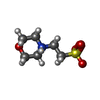+ Open data
Open data
- Basic information
Basic information
| Entry | Database: PDB / ID: 6zzz | ||||||
|---|---|---|---|---|---|---|---|
| Title | Crystal structure of yeast Sec62 cytoplasmic domain | ||||||
 Components Components | Translocation protein SEC62 | ||||||
 Keywords Keywords |  PROTEIN TRANSPORT / PROTEIN TRANSPORT /  Sec62 / Sec62 /  Sec62 domain / Post translocon Sec62 domain / Post translocon | ||||||
| Function / homology |  Function and homology information Function and homology informationSec62/Sec63 complex /  translocon complex / rough endoplasmic reticulum membrane / translocon complex / rough endoplasmic reticulum membrane /  post-translational protein targeting to membrane, translocation / protein transmembrane transporter activity / post-translational protein targeting to membrane, translocation / protein transmembrane transporter activity /  endoplasmic reticulum / endoplasmic reticulum /  membrane membraneSimilarity search - Function | ||||||
| Biological species |   Saccharomyces cerevisiae (brewer's yeast) Saccharomyces cerevisiae (brewer's yeast) | ||||||
| Method |  X-RAY DIFFRACTION / X-RAY DIFFRACTION /  SYNCHROTRON / SYNCHROTRON /  SAD / Resolution: 2.54 Å SAD / Resolution: 2.54 Å | ||||||
 Authors Authors | Cheng, J. / Beckmann, R. | ||||||
 Citation Citation |  Journal: EMBO J / Year: 2021 Journal: EMBO J / Year: 2021Title: Architecture of the active post-translational Sec translocon. Authors: Tsai-Hsuan Weng / Wieland Steinchen / Birgitta Beatrix / Otto Berninghausen / Thomas Becker / Gert Bange / Jingdong Cheng / Roland Beckmann /  Abstract: In eukaryotes, most secretory and membrane proteins are targeted by an N-terminal signal sequence to the endoplasmic reticulum, where the trimeric Sec61 complex serves as protein-conducting channel ...In eukaryotes, most secretory and membrane proteins are targeted by an N-terminal signal sequence to the endoplasmic reticulum, where the trimeric Sec61 complex serves as protein-conducting channel (PCC). In the post-translational mode, fully synthesized proteins are recognized by a specialized channel additionally containing the Sec62, Sec63, Sec71, and Sec72 subunits. Recent structures of this Sec complex in the idle state revealed the overall architecture in a pre-opened state. Here, we present a cryo-EM structure of the yeast Sec complex bound to a substrate, and a crystal structure of the Sec62 cytosolic domain. The signal sequence is inserted into the lateral gate of Sec61α similar to previous structures, yet, with the gate adopting an even more open conformation. The signal sequence is flanked by two Sec62 transmembrane helices, the cytoplasmic N-terminal domain of Sec62 is more rigidly positioned, and the plug domain is relocated. We crystallized the Sec62 domain and mapped its interaction with the C-terminus of Sec63. Together, we obtained a near-complete and integrated model of the active Sec complex. | ||||||
| History |
|
- Structure visualization
Structure visualization
| Structure viewer | Molecule:  Molmil Molmil Jmol/JSmol Jmol/JSmol |
|---|
- Downloads & links
Downloads & links
- Download
Download
| PDBx/mmCIF format |  6zzz.cif.gz 6zzz.cif.gz | 79.9 KB | Display |  PDBx/mmCIF format PDBx/mmCIF format |
|---|---|---|---|---|
| PDB format |  pdb6zzz.ent.gz pdb6zzz.ent.gz | 52.9 KB | Display |  PDB format PDB format |
| PDBx/mmJSON format |  6zzz.json.gz 6zzz.json.gz | Tree view |  PDBx/mmJSON format PDBx/mmJSON format | |
| Others |  Other downloads Other downloads |
-Validation report
| Arichive directory |  https://data.pdbj.org/pub/pdb/validation_reports/zz/6zzz https://data.pdbj.org/pub/pdb/validation_reports/zz/6zzz ftp://data.pdbj.org/pub/pdb/validation_reports/zz/6zzz ftp://data.pdbj.org/pub/pdb/validation_reports/zz/6zzz | HTTPS FTP |
|---|
-Related structure data
- Links
Links
- Assembly
Assembly
| Deposited unit | 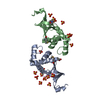
| ||||||||||||||||||||||||||||||||||||
|---|---|---|---|---|---|---|---|---|---|---|---|---|---|---|---|---|---|---|---|---|---|---|---|---|---|---|---|---|---|---|---|---|---|---|---|---|---|
| 1 | 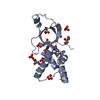
| ||||||||||||||||||||||||||||||||||||
| 2 | 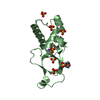
| ||||||||||||||||||||||||||||||||||||
| Unit cell |
| ||||||||||||||||||||||||||||||||||||
| Noncrystallographic symmetry (NCS) | NCS domain:
NCS domain segments:
|
- Components
Components
| #1: Protein | Mass: 15170.269 Da / Num. of mol.: 2 Source method: isolated from a genetically manipulated source Source: (gene. exp.)   Saccharomyces cerevisiae (strain ATCC 204508 / S288c) (yeast) Saccharomyces cerevisiae (strain ATCC 204508 / S288c) (yeast)Strain: ATCC 204508 / S288c / Gene: SEC62, YPL094C, LPG14C / Production host:   Escherichia coli (E. coli) / References: UniProt: P21825 Escherichia coli (E. coli) / References: UniProt: P21825#2: Chemical |  Glycerol Glycerol#3: Chemical | ChemComp-SO4 /  Sulfate Sulfate#4: Chemical | ChemComp-MES / |  MES (buffer) MES (buffer)#5: Water | ChemComp-HOH / |  Water WaterHas ligand of interest | N | |
|---|
-Experimental details
-Experiment
| Experiment | Method:  X-RAY DIFFRACTION / Number of used crystals: 1 X-RAY DIFFRACTION / Number of used crystals: 1 |
|---|
- Sample preparation
Sample preparation
| Crystal | Density Matthews: 3.64 Å3/Da / Density % sol: 66.25 % |
|---|---|
Crystal grow | Temperature: 277 K / Method: vapor diffusion, hanging drop / Details: 100mM MES pH 5.7-5.9, 2 M (NH4)2SO4 / PH range: 5.7-5.9 |
-Data collection
| Diffraction | Mean temperature: 100 K / Serial crystal experiment: N |
|---|---|
| Diffraction source | Source:  SYNCHROTRON / Site: SYNCHROTRON / Site:  ESRF ESRF  / Beamline: BM02 / Wavelength: 0.97958 Å / Beamline: BM02 / Wavelength: 0.97958 Å |
| Detector | Type: DECTRIS EIGER X 16M / Detector: PIXEL / Date: May 19, 2017 |
| Radiation | Protocol: SINGLE WAVELENGTH / Monochromatic (M) / Laue (L): M / Scattering type: x-ray |
| Radiation wavelength | Wavelength : 0.97958 Å / Relative weight: 1 : 0.97958 Å / Relative weight: 1 |
| Reflection | Resolution: 2.54→47.26 Å / Num. obs: 15563 / % possible obs: 99.81 % / Redundancy: 38.1 % / Biso Wilson estimate: 74.11 Å2 / CC1/2: 1 / CC star: 1 / Rmerge(I) obs: 0.1075 / Rpim(I) all: 0.01778 / Rrim(I) all: 0.109 / Net I/σ(I): 26.56 |
| Reflection shell | Resolution: 2.54→2.63 Å / Rmerge(I) obs: 1.869 / Mean I/σ(I) obs: 2.03 / Num. unique obs: 1495 / CC1/2: 0.949 / Rrim(I) all: 1.894 |
- Processing
Processing
| Software |
| |||||||||||||||||||||||||||||||||||||||||||||||||
|---|---|---|---|---|---|---|---|---|---|---|---|---|---|---|---|---|---|---|---|---|---|---|---|---|---|---|---|---|---|---|---|---|---|---|---|---|---|---|---|---|---|---|---|---|---|---|---|---|---|---|
| Refinement | Method to determine structure : :  SAD / Resolution: 2.54→47.26 Å / SU ML: 0.3284 / Cross valid method: FREE R-VALUE / σ(F): 1.38 / Phase error: 27.2985 SAD / Resolution: 2.54→47.26 Å / SU ML: 0.3284 / Cross valid method: FREE R-VALUE / σ(F): 1.38 / Phase error: 27.2985 Stereochemistry target values: GeoStd + Monomer Library + CDL v1.2
| |||||||||||||||||||||||||||||||||||||||||||||||||
| Solvent computation | Shrinkage radii: 0.9 Å / VDW probe radii: 1.11 Å / Solvent model: FLAT BULK SOLVENT MODEL | |||||||||||||||||||||||||||||||||||||||||||||||||
| Displacement parameters | Biso mean: 75.34 Å2 | |||||||||||||||||||||||||||||||||||||||||||||||||
| Refinement step | Cycle: LAST / Resolution: 2.54→47.26 Å
| |||||||||||||||||||||||||||||||||||||||||||||||||
| Refine LS restraints |
| |||||||||||||||||||||||||||||||||||||||||||||||||
| LS refinement shell |
|
 Movie
Movie Controller
Controller





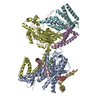
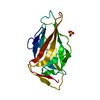
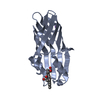
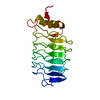
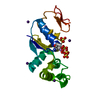
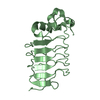
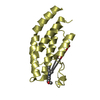
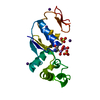
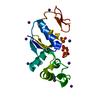
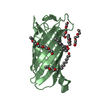
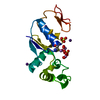
 PDBj
PDBj



